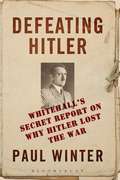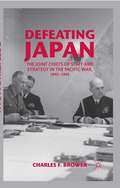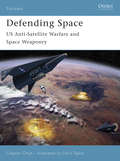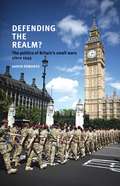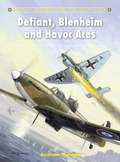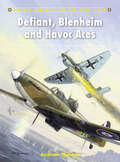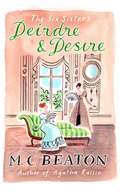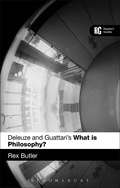- Table View
- List View
Decentralization and Popular Democracy: Governance from Below in Bolivia
by Jean Paul FaguetBolivia decentralized in an effort to deepen democracy, improve public services, and make government more accountable. Unlike many countries, Bolivia succeeded. Over the past generation, public investment shifted dramatically toward primary services and resource distribution became far more equitable, partly due to the creation of new local governments. Many municipalities responded to decentralization with transparent, accountable government, yet others suffered ineptitude, corruption, or both. Why? Jean-Paul Faguet combines broad econometric data with deep qualitative evidence to investigate the social underpinnings of governance. He shows how the interaction of civic groups and business interests determines the quality of local decision making. In order to understand decentralization, Faguet argues, we must understand governance from the ground up. Drawing on his findings, he offers an evaluation of the potential benefits of decentralization and recommendations for structuring successful reform.
The Decisive Duel: Spitfire vs 109
by David IsbyLondon, 15 September 1940. The air battle over Britain on that day saw two of the most advanced fighter planes, the British Supermarine Spitfire and the German Messerschmitt Bf 109, battle for supremacy of the skies. The Decisive Duel tells the stories of these iconic, classic aircraft and the people that created them: Willy Messerschmitt, the German designer with a love for gliders and admiration for Hitler; R.J. Mitchell, his brilliant British counterpart, who struggled against illness to complete the design of the Spitfire. In fascinating detail, David Isby describes the crucial role the two opposed planes played, from the drawing boards to Dunkirk, the Battle of Britain to the final battles over Germany.
Decisive Meals: Table Politics in Biblical Literature (The Library of New Testament Studies #449)
by Nathan MacDonald Kathy Ehrensperger Luzia Sutter RehmannDecisive Meals discusses various aspects of meal traditions and their relevance in terms of boundaries between different groups in the context of first century Judaism and the early Christ-movement. The contributors discuss different communities at different times and places - under the same focus of common meals: The post-exilic community in Judaea, the Pauline communities in Asia Minor, as well as in the Roman dominated city of Caesarea and the Hellenistic Jewish community and the emerging rabbinical community - each time a community is affected through the sharing of meals, but how exactly? What are similar effects - where are the differences? This sheds light on power dynamics between rich and poor, well fed and hungry, but also between men and women. These questions will clarify how detailed exegesis is influenced by hermeneutical patterns and ideas about food, boundaries and power dynamics.
The Decline of Therapeutic Bloodletting and the Collapse of Traditional Medicine
by K. Codell CarterOver the course of a single generation, without significant discussion or debate, a key practice of traditional medicine was almost completely abandoned in mid-nineteenth-century Europe. K. Codell Carter's book describes how and why bloodletting was abandoned, noting that it was part of a process in which innovation was required so that modern scientific medicine could begin. This book is a masterful study on the collapse of a traditional medical practice. Bloodletting had been a prominent medical therapy in early nineteenth-century Europe and can be traced back to Greek and Roman physicians. The Hippocratic corpus contains several discussions of bloodletting. Galen, the most famous physician in classical antiquity, wrote tracts explaining and defending the practice. It was employed in ancient Egypt and is the most commonly mentioned therapy in the Babylonian Talmud. Indeed, it was practiced in virtually every part of the ancient world. Even though the practice abruptly ceased, there was little argument against it or reason to believe it ineffective. In reality, bloodletting actually worked. However, the rise of modern medicine required not just a change in how disease and causation were conceived, but also a change in the role of medicine in society. It has been claimed that the collapse of traditional medicine was a precondition for the rise of modern medicine, but there has been little support for this assertion before now. Carter provides this missing support. The result is a fascinating study in the history of medical practice and social expectations.
The Decline of Therapeutic Bloodletting and the Collapse of Traditional Medicine
by K. Codell CarterOver the course of a single generation, without significant discussion or debate, a key practice of traditional medicine was almost completely abandoned in mid-nineteenth-century Europe. K. Codell Carter's book describes how and why bloodletting was abandoned, noting that it was part of a process in which innovation was required so that modern scientific medicine could begin. This book is a masterful study on the collapse of a traditional medical practice. Bloodletting had been a prominent medical therapy in early nineteenth-century Europe and can be traced back to Greek and Roman physicians. The Hippocratic corpus contains several discussions of bloodletting. Galen, the most famous physician in classical antiquity, wrote tracts explaining and defending the practice. It was employed in ancient Egypt and is the most commonly mentioned therapy in the Babylonian Talmud. Indeed, it was practiced in virtually every part of the ancient world. Even though the practice abruptly ceased, there was little argument against it or reason to believe it ineffective. In reality, bloodletting actually worked. However, the rise of modern medicine required not just a change in how disease and causation were conceived, but also a change in the role of medicine in society. It has been claimed that the collapse of traditional medicine was a precondition for the rise of modern medicine, but there has been little support for this assertion before now. Carter provides this missing support. The result is a fascinating study in the history of medical practice and social expectations.
Decoding Modern Consumer Societies (Worlds of Consumption)
by Hartmut Berghoff and Uwe SpiekermannDrawing on a wide range of studies of Europe, the United States, Asia, and Africa, the contributions gathered here consider how political history, business history, the history of science, cultural history, gender history, intellectual history, anthropology, and even environmental history can help us decode modern consumer societies.
Decoding Subaltern Politics: Ideology, Disguise, and Resistance in Agrarian Politics (Asia's Transformations/Critical Asian Scholarship)
by James C. ScottJames C. Scott has researched and written on subaltern groups, and, in particular, peasants, rebellion, resistance, and agriculture, for over 35 years. Yet much of Scott’s most interesting work on the peasantry and the state, both conceptually and empirically, has never been published in book form. For the first time Decoding Subaltern Politics: Ideology, Disguise, and Resistance in Agrarian Politics, brings together some of his most important work in one volume. The book covers three distinct yet interlinked bodies of work. The first lays out a framework for understanding peasant politics and rebellion, much of which is applicable to rural areas of the contemporary global south. Scott then goes on to develop his arguments regarding everyday forms of peasant resistance using the comparative example of the religious tithe in France and Malaysia, and tracing the forms of resistance that cover their own tracks and avoid direct clashes with authorities. For much of the world’s population, and for most of its history, this sort of politics was far more common than the violent clashes that dominate the history books, and in this book one can examine the anatomy of such resistance in rich comparative detail. Finally, Scott explores how the state’s increasing grip on its population: its identity, land-holding, income, and movements, is a precondition for political hegemony. Crucially, in examining the invention of state-mandated legal identities, especially, the permanent patronym and the vagaries of its imposition on vernacular life, Scott lays bare the micro-processes of state-formation and resistance. Written by one of the leading social theorists of our age, Decoding Subaltern Politics: Ideology, Disguise, and Resistance in Agrarian Politics is an indispensible guide to the study of subaltern culture and politics and is essential reading for political scientists, anthropologists, sociologists and historians alike.
Decoding Subaltern Politics: Ideology, Disguise, and Resistance in Agrarian Politics (Asia's Transformations/Critical Asian Scholarship)
by James C. ScottJames C. Scott has researched and written on subaltern groups, and, in particular, peasants, rebellion, resistance, and agriculture, for over 35 years. Yet much of Scott’s most interesting work on the peasantry and the state, both conceptually and empirically, has never been published in book form. For the first time Decoding Subaltern Politics: Ideology, Disguise, and Resistance in Agrarian Politics, brings together some of his most important work in one volume. The book covers three distinct yet interlinked bodies of work. The first lays out a framework for understanding peasant politics and rebellion, much of which is applicable to rural areas of the contemporary global south. Scott then goes on to develop his arguments regarding everyday forms of peasant resistance using the comparative example of the religious tithe in France and Malaysia, and tracing the forms of resistance that cover their own tracks and avoid direct clashes with authorities. For much of the world’s population, and for most of its history, this sort of politics was far more common than the violent clashes that dominate the history books, and in this book one can examine the anatomy of such resistance in rich comparative detail. Finally, Scott explores how the state’s increasing grip on its population: its identity, land-holding, income, and movements, is a precondition for political hegemony. Crucially, in examining the invention of state-mandated legal identities, especially, the permanent patronym and the vagaries of its imposition on vernacular life, Scott lays bare the micro-processes of state-formation and resistance. Written by one of the leading social theorists of our age, Decoding Subaltern Politics: Ideology, Disguise, and Resistance in Agrarian Politics is an indispensible guide to the study of subaltern culture and politics and is essential reading for political scientists, anthropologists, sociologists and historians alike.
Decolonizing the Body of Christ: Theology and Theory after Empire? (Postcolonialism and Religions)
by David Joy and Joseph F. DugganThe first book in the new Postcolonialism and Religions series offers a preview of the series focus on multireligious, indigenous, and transnational scholarly voices. In this book, the once arch enemies of Religious studies and Postcolonial theory become critical companions in shared analysis of major postcolonial themes.
Deconstructing International Politics (Interventions)
by Michael DillonMichael Dillon is internationally regarded for his contributions by political philosophers, international relations scholars and security studies experts, as well as by philosophers more broadly. It is difficult to overrate his importance to the development of critical deconstructive approaches not only in challenging traditional scholarship and addressing contemporary politics, but in articulating new approaches and new thinking. This book draws together some of his key works and is framed by an introduction written specially for the volume. It is the first full-length work to draw on the insights and techniques of deconstruction to analyse international relations. Influenced primarily by Derrida, it critiques the cornerstones of international relations such as modernity, the state, the subject, security and ethics and justice. This volume will provide an invaluable resource for teaching at undergraduate and postgraduate levels on traditional international relations courses and on the increasing number of specialised courses in critical approaches. Well designed and structured, it is accessible to the novice as well as challenging for the specialist.
Deconstructing International Politics (Interventions)
by Michael DillonMichael Dillon is internationally regarded for his contributions by political philosophers, international relations scholars and security studies experts, as well as by philosophers more broadly. It is difficult to overrate his importance to the development of critical deconstructive approaches not only in challenging traditional scholarship and addressing contemporary politics, but in articulating new approaches and new thinking. This book draws together some of his key works and is framed by an introduction written specially for the volume. It is the first full-length work to draw on the insights and techniques of deconstruction to analyse international relations. Influenced primarily by Derrida, it critiques the cornerstones of international relations such as modernity, the state, the subject, security and ethics and justice. This volume will provide an invaluable resource for teaching at undergraduate and postgraduate levels on traditional international relations courses and on the increasing number of specialised courses in critical approaches. Well designed and structured, it is accessible to the novice as well as challenging for the specialist.
Defeating Hitler: Whitehall's Secret Report on Why Hitler Lost the War
by Paul WinterPublished for the very first time, the top secret report Some Weaknesses in German Strategy and Organisation 1933 - 1945 was prepared by Whitehall's highest intelligence body, the Joint Intelligence Committee, and presented to Britain's Chiefs of Staff in 1946 to 'set down certain aspects of the War whilst there are still sources available who were closely connected with the events described'. Paul Winter sets this unique and important document in its historical setting, providing biographies of key figures referenced in the report and a timeline of the crucial events of the Second World War.
Defeating Hitler: Whitehall's Secret Report on Why Hitler Lost the War
by Paul WinterPublished for the very first time, the top secret report Some Weaknesses in German Strategy and Organisation 1933 - 1945 was prepared by Whitehall's highest intelligence body, the Joint Intelligence Committee, and presented to Britain's Chiefs of Staff in 1946 to 'set down certain aspects of the War whilst there are still sources available who were closely connected with the events described'. Paul Winter sets this unique and important document in its historical setting, providing biographies of key figures referenced in the report and a timeline of the crucial events of the Second World War.
Defeating Japan: The Joint Chiefs of Staff and Strategy in the Pacific War, 1943–1945
by Charles F. BrowerThis book argues that American strategists in the Joint Chiefs of Staff were keenly aware of the inseparability of political and military aspects of strategy in the fight against Japan in World War II. They understood that war not only has political sources, it also has political purposes that establish the war's objectives and help to define the nature of the peace to follow. They understood that policy was the 'guiding intelligence' for war, in Clausewitzian terms, and that to attempt to approach strategic problems was nonsensical.
Defending London: A Military History from Conquest to Cold War
by Mike OsborneFor two thousand years London has been at the heart of Britain’s development as a nation, providing a focus for its political life. The military element is now usually visible only through the pageantry which attends royal occasions, but this masks a more serious underlying intent. Frequently the target for both foreign invaders and domestic factions, it has been required to defend itself against everything from seaborne raiders to aerial bombardment and the threat of nuclear war. At the same time, the direction of military affairs has been centred on London, along with the military infrastructure of barracks, depots, magazines, dockyards and munitions factories. The evidence for much of this can be seen in the landscape, from the mediaeval Tower of London and the underground nuclear citadels in the urban centre, to the royal palaces, moated sites, airfields and anti-invasion defences in the suburbs and the green belt. This book describes the various elements of London’s military heritage, and places them in their historical and social context. From the castles and strong-houses of the mediaeval and Tudor monarchs and statesmen, to the pseudo-fortresses of the Victorian militia and rifle volunteers; the airfields of the anti-Zeppelin fighters of the Royal Flying Corps, and the Battle of Britain bases of the RAF, to the pillboxes of the defences against invasion in 1940, and the anti-nuclear defences of the Cold War and beyond.
Defending Space: US Anti-Satellite Warfare and Space Weaponry (Fortress #53)
by Clayton Chun Chris TaylorThe United States has been developing space for many years, and satellites provide the US Military with an unparaleled advantage over its adversaries. Constellations of both military and civilian satellites provide protection and support for military operations; deliver ballistic missile early warning; supply reliable, secure and jam-proof communications; gather audio-visual intelligence; predict weather patterns; guide navigation; and deliver guided-weapons targeting, as well as a host of other missions. This book explores the design, development and usage of US military space systems, as well past and future threats to the systems. The current relevance of this topic to the international community as a whole is key, as space becomes the next, if only virtual, theater of warfare.
Defending the realm?: The politics of Britain’s small wars since 1945
by Aaron EdwardsBritain is often revered for its extensive experience of waging ‘small wars’. Its long imperial history is littered with high profile counter-insurgency campaigns, thus marking it out as the world’s most seasoned practitioner of this type of warfare. This is the first book to detail the tactical and operational dynamics of Britain’s small wars, arguing that the military’s use of force was more heavily constrained by wider strategic and political considerations than previously admitted. Outlining the civil-military strategy followed by the British in Palestine, Malaya, Kenya, Cyprus, Aden, Northern Ireland, Iraq and Afghanistan, Defending the realm? argues that Britain’s small wars since 1945 were fought against the backdrop of an irrevocable decline in British power. Written from a theoretically-informed perspective, grounded in rich archival sources, oral testimonies and a revisionist reading of the literature on counter-insurgency and counter-terrorism, this is the definitive account of the politics of Britain’s small wars.
Defiant, Blenheim and Havoc Aces (Aircraft of the Aces)
by Chris Davey Andrew ThomasThe Blenheim IF flew some of Fighter Command's early offensive operations, and the type soon proved vulnerable when pitted against single-seat fighters. However, for much of 1940 the Blenheim fighter squadrons provided the RAF's main long-range convoy escort and nightfighter capability. In the mid-1930s, in an attempt to capitalise on its expertise in power-operated gun turrets, the Boulton Paul Company developed the Defiant, a single-engined fighter in which all the armament was concentrated in the turret behind the pilot. Intended as a 'bomber destroyer', the Defiant had its combat debut over Dunkirk, and initially achieved some considerable success. A number of American-built aircraft called Douglas DB-7 light bombers (named Havoc by the RAF), were fitted with radar for nightfighter duties and others successfully replaced the Blenheim as night intruders. A total of 11 pilots claimed five or more victories when flying these three types to become aces, whilst no fewer than 33 who became aces claimed at least part of their scores when flying the Blenheim, Defiant or Havoc.
Defiant, Blenheim and Havoc Aces (Aircraft of the Aces #105)
by Andrew ThomasThe Blenheim IF flew some of Fighter Command's early offensive operations, and the type soon proved vulnerable when pitted against single-seat fighters. However, for much of 1940 the Blenheim fighter squadrons provided the RAF's main long-range convoy escort and nightfighter capability. In the mid-1930s, in an attempt to capitalise on its expertise in power-operated gun turrets, the Boulton Paul Company developed the Defiant, a single-engined fighter in which all the armament was concentrated in the turret behind the pilot. Intended as a 'bomber destroyer', the Defiant had its combat debut over Dunkirk, and initially achieved some considerable success. A number of American-built aircraft called Douglas DB-7 light bombers (named Havoc by the RAF), were fitted with radar for nightfighter duties and others successfully replaced the Blenheim as night intruders. A total of 11 pilots claimed five or more victories when flying these three types to become aces, whilst no fewer than 33 who became aces claimed at least part of their scores when flying the Blenheim, Defiant or Havoc.
Define and Rule: Native as Political Identity (W. E. B. Du Bois Lectures)
by Mahmood MamdaniWhen Britain abandoned its attempt to eradicate difference between conqueror and conquered and introduced a new idea of governance as the definition and management of difference, lines of political identity were drawn between settler and native, and between natives according to tribe. Out of this colonial experience arose a language of pluralism.
Define and Rule: Native as Political Identity (W. E. B. Du Bois Lectures)
by Mahmood MamdaniWhen Britain abandoned its attempt to eradicate difference between conqueror and conquered and introduced a new idea of governance as the definition and management of difference, lines of political identity were drawn between settler and native, and between natives according to tribe. Out of this colonial experience arose a language of pluralism.
Deirdre and Desire: A Novel Of Regency England - The Third Volume Of The Six Sisters (The Six Sisters Series #3)
by M.C. BeatonRed-haired, jade-eyed Deirdre is determined to marry for Love - nothing else will do. So the fact her father's candidate for her hand, Lord Harry Desire, is well bred and good looking, interests her not a jot! But the feelings he arouses in her are truly distracting.Deirdre's discovery of what desire can mean and where her heart really lies brings about a delicious climax to this adventure of intrigue, misunderstanding - and love!
Deleuze and Guattari's 'What is Philosophy?': A Reader's Guide (Reader's Guides)
by Rex ButlerWhat is Philosophy? is the last instalment of a remarkable twenty-year collaboration between the philosopher Gilles Deleuze and the psychoanalyst Félix Guattari. This hugely important text attempts to explain the terms of their collaboration and to define the activity of philosophy in which they have been engaged. A major contribution to contemporary Continental philosophy, it nevertheless remains distinctly challenging for readers faced for the first time with Deleuze and Guattari's unusual and somewhat allusive style.Deleuze and Guattari's 'What is Philosophy?': A Reader's Guide offers a concise and accessible introduction to this hugely important and yet challenging work. Written specifically to meet the needs of students coming to Deleuze and Guattari for the first time, the book offers guidance on: - Philosophical and historical context - Key themes - Reading the text - Reception and influence - Further reading
Deleuze and the Diagram: Aesthetic Threads in Visual Organization (Continuum Studies in Continental Philosophy)
by Jakub ZdebikDeleuze and the Diagram charts Deleuze's corpus according to aesthetic concepts such as the map, the sketch and the drawing to bring out a comprehensive concept of the diagram. In his interrogation of Deleuze's visual aesthetic theory, Jakub Zdebik focuses on artists that hold an important place in Deleuze's system. The art of Paul Klee and Francis Bacon is presented as the visual manifestation of Deleuze's philosophy and yields novel ways of assessing visual culture. Zdebik goes on to compare Deleuze's philosophy with the visual theories of Foucault, Lyotard and Simondon, as well as the aesthetic philosophy of Heidegger and Kant. He shows how the visual and aesthetic elements of the diagram shed new light on Deleuze's writings.Deleuze conceptualized his theory as a form of painting, saying that, like art, it needed to shift from figuration to abstraction. This book focuses on the visual devices in Deleuze's work and uses the concept of the diagram to describe the relationship between philosophy and art and to formulate a way to think about philosophy through art.
Deleuze and the Diagram: Aesthetic Threads in Visual Organization (Continuum Studies in Continental Philosophy #32)
by Jakub ZdebikDeleuze and the Diagram charts Deleuze's corpus according to aesthetic concepts such as the map, the sketch and the drawing to bring out a comprehensive concept of the diagram. In his interrogation of Deleuze's visual aesthetic theory, Jakub Zdebik focuses on artists that hold an important place in Deleuze's system. The art of Paul Klee and Francis Bacon is presented as the visual manifestation of Deleuze's philosophy and yields novel ways of assessing visual culture. Zdebik goes on to compare Deleuze's philosophy with the visual theories of Foucault, Lyotard and Simondon, as well as the aesthetic philosophy of Heidegger and Kant. He shows how the visual and aesthetic elements of the diagram shed new light on Deleuze's writings.Deleuze conceptualized his theory as a form of painting, saying that, like art, it needed to shift from figuration to abstraction. This book focuses on the visual devices in Deleuze's work and uses the concept of the diagram to describe the relationship between philosophy and art and to formulate a way to think about philosophy through art.








